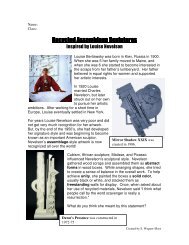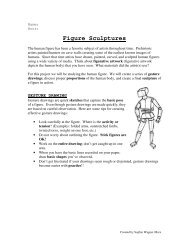Gargoyle Handout
Gargoyle Handout
Gargoyle Handout
- No tags were found...
You also want an ePaper? Increase the reach of your titles
YUMPU automatically turns print PDFs into web optimized ePapers that Google loves.
Name:Hour:<strong>Gargoyle</strong>s & GrotesquesOver 800 years ago gargoyles were a common featureon gothic churches and buildings in medieval Europe.<strong>Gargoyle</strong>s are carved sculptures that serve asrainspouts. When translated in various Europeanlanguages, the function of the gargoyle is directlyreflected in its name. In German gargoyle means“water spitter,” in French and Spanish it is “gullet” or“throat,” and in Dutch it means “water vomiter.”<strong>Gargoyle</strong>s are functional art. Functional art serves aphysical purpose. <strong>Gargoyle</strong>-like decorations that do not drain water are calledgrotesques. Unlike gargoyles, which can only be found on the outsides of buildings,grotesques can be found outside or inside.The BeginningSince very little, if anything, is written about specific gargoyles or carvers duringmedieval Europe, we cannot fully understand their symbolic meaning. Instead we haveto try and interpret them based on what we see. We have to let the scupture tell the story!A popular explanation is that medieval gargoyles were used to ward off evil. Thegrotesque-looking gargoyles were meant to keep evil from entering the churches so thechurch-goers were safe inside. They may also have been a warning of the evils ofsinning.A second explanation is that Christians used the gargoyles to lure non-Christians intothe church. There is a legend that Celtic people in medieval Europe hung animal headson their houses because they believed it brought them luck. Christians imitated thistradition by carving animal-like faces onto the churches. They hoped this would attractthe Celts, bringing them into the church where they could be converted to Christianity.A third explanation is a myth that describes how a dragon named “La Gargouille”terrorized a French town. A visiting priest promised to rid the town of the dragon if thetownspeople promised to help build a church and be baptized. The priest saw this as agreat opportunity to recruit members since very few people were Christian at the time.After the townspeople promised, the priest went out and tamed the dragon. When hebrought it back to the town, the people tried to burn the dragon. The only part that wouldnot burn was the head because it was used to fire and heat. The priest hung the head onthe outside of the church as a reminder of the good religion could do.<strong>Handout</strong> created by S. Wagner-Marx
American <strong>Gargoyle</strong>s<strong>Gargoyle</strong>s continue to stare down at us from many buildings.You can visit the millions of medieval gargoyles in many parts ofEurope. You can also see modern gargoyles in many parts of theUnited States. Big cities are the best places to hunt for gargoyles;keep your eyes tilted upward!For the most part, modern gargoyles are easier to interpretbecause there is more documentation we can read. In general, weknow that modern gargoyles are more secular (less religious),and tend to have more human characteristics.We also know that American gargoyles frequently reflect the activities that take placeinside the buildings they decorate. For example, on the Princeton campus, living animalsare depicted on the Biology building and extinct animals are depicted on the Geologybuilding. The gymnasium at Princeton has athletic gargoyles on it, including a footballplayer and a weightlifter.ProcessBefore a carver begins creating the actual gargoyle, asculptor designs a model of the gargoyle out of clay.(On occasion the carver and the sculptor are the sameperson, but frequently they are two different artists!)The picture on the right is of Walter Arnold, an artistfrom Chicago who designs and carves gargoyles allover the world.⇒You will be designing and creating your ownmodel of a gargoyle or grotesque.Think About:• What kind of person does your gargoylerepresent?• What is your gargoyles personality (is itplayful, serious, mischeivious, etc?)• What expression will your gargoyle wear?• Which feature will you exaggerate?• What is your gargoyles name?Brainstorm ideas in the box below.<strong>Handout</strong> created by S. Wagner-Marx
⇒Draw 3 thumbnail sketches of gargoyles you might create. Keep in mindthat you want to concentrate on:• exaggerating one feature• adding texture• making it dynamic (what will stand out or create shadows?)• using animal and human features• making your gargoyle unique⇒Choose your favorite gargoyle or grotesque sketch and circle it.Transform your sketch into a 3D gargoyle model! (Ms. W will haveguidelines how to work with the clay.)ResourcesI read two books about gargoyles to get ready for this project. They are:American <strong>Gargoyle</strong>s: Spirits in Stone by Darlene TrewCrist, Photography by Robert LlewellynHoly Terrors: <strong>Gargoyle</strong>s on Medieval Buildings by JanettaRebold BentonSome stories and poems about <strong>Gargoyle</strong>s are:• Night of the <strong>Gargoyle</strong>s by Eve Bunting, Illustrated by David Wiesner• The <strong>Gargoyle</strong> on the Roof by Jack Prelutsky, Illustrated by Peter SisSome websites about <strong>Gargoyle</strong>s are:• http://www.stonecarver.com• http://www.stratis.demon.co.uk/gargoyles/gargoyle.htm<strong>Handout</strong> created by S. Wagner-Marx
















